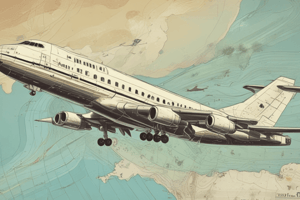Podcast
Questions and Answers
What occurs when a cold front advances towards a warmer air mass?
What occurs when a cold front advances towards a warmer air mass?
What is the primary difference between a stationary front and a warm front?
What is the primary difference between a stationary front and a warm front?
What is the primary influence of air masses on aircraft performance?
What is the primary influence of air masses on aircraft performance?
What is the primary concern for pilots when flying near an occluded front?
What is the primary concern for pilots when flying near an occluded front?
Signup and view all the answers
Why is it essential for pilots to understand the behavior of air masses and fronts?
Why is it essential for pilots to understand the behavior of air masses and fronts?
Signup and view all the answers
What is a characteristic of warm fronts?
What is a characteristic of warm fronts?
Signup and view all the answers
How do air masses and fronts influence aviation weather conditions?
How do air masses and fronts influence aviation weather conditions?
Signup and view all the answers
What is the primary consequence of a cold front catching up to a warm front?
What is the primary consequence of a cold front catching up to a warm front?
Signup and view all the answers
What is the primary benefit of understanding air masses and fronts for pilots?
What is the primary benefit of understanding air masses and fronts for pilots?
Signup and view all the answers
What is a characteristic of cold fronts?
What is a characteristic of cold fronts?
Signup and view all the answers
Cold fronts are always associated with clear skies and warm weather.
Cold fronts are always associated with clear skies and warm weather.
Signup and view all the answers
Warm fronts always lead to complex weather patterns.
Warm fronts always lead to complex weather patterns.
Signup and view all the answers
Stationary fronts are always characterized by rapidly changing weather conditions.
Stationary fronts are always characterized by rapidly changing weather conditions.
Signup and view all the answers
Occluded fronts occur when a warm front catches up to a cold front.
Occluded fronts occur when a warm front catches up to a cold front.
Signup and view all the answers
Pilots only need to consider the stability of the air mass when flying near fronts.
Pilots only need to consider the stability of the air mass when flying near fronts.
Signup and view all the answers
Understanding air masses and fronts is only important for pilots to ensure passenger comfort.
Understanding air masses and fronts is only important for pilots to ensure passenger comfort.
Signup and view all the answers
Air masses and fronts have a limited impact on aviation weather conditions.
Air masses and fronts have a limited impact on aviation weather conditions.
Signup and view all the answers
Warm air always rises over cold air when a warm front forms.
Warm air always rises over cold air when a warm front forms.
Signup and view all the answers
Cold fronts are typically associated with prolonged precipitation.
Cold fronts are typically associated with prolonged precipitation.
Signup and view all the answers
Pilots can always predict the exact behavior of air masses and fronts.
Pilots can always predict the exact behavior of air masses and fronts.
Signup and view all the answers
What weather patterns can occur when a cold front forces warm air to rise rapidly?
What weather patterns can occur when a cold front forces warm air to rise rapidly?
Signup and view all the answers
How does the warm air behave when a warm front forms?
How does the warm air behave when a warm front forms?
Signup and view all the answers
What can happen to the weather near a stationary front?
What can happen to the weather near a stationary front?
Signup and view all the answers
What is the result of a cold front catching up to a warm front?
What is the result of a cold front catching up to a warm front?
Signup and view all the answers
How do pilots benefit from understanding air masses and fronts?
How do pilots benefit from understanding air masses and fronts?
Signup and view all the answers
What is a key factor pilots must consider when flying near fronts?
What is a key factor pilots must consider when flying near fronts?
Signup and view all the answers
What can influence aircraft performance near fronts?
What can influence aircraft performance near fronts?
Signup and view all the answers
What is a challenge pilots may face during takeoffs and landings near fronts?
What is a challenge pilots may face during takeoffs and landings near fronts?
Signup and view all the answers
What is the result of a comprehensive analysis of air masses and fronts?
What is the result of a comprehensive analysis of air masses and fronts?
Signup and view all the answers
Why is it crucial for pilots to anticipate and respond to weather changes?
Why is it crucial for pilots to anticipate and respond to weather changes?
Signup and view all the answers
Study Notes
Air Masses and Their Characteristics
- An air mass is a large body of air with uniform temperature, humidity, and pressure properties.
- Air masses can be classified into two main types: tropical and polar, based on their formation region's latitude.
- Tropical air masses are warm and form in low-latitude regions, while polar air masses are cold and form in high-latitude areas.
- Air masses can also be classified as maritime or continental, based on their formation over water or land, respectively.
- Maritime air masses are moist, while continental air masses are relatively dry.
Seasonal Variations of Air Masses
- Air masses change character with the seasons due to the shift in solar radiation distribution.
- During summer, continental tropical air masses intensify over land, bringing hot weather.
- In winter, polar regions reinforce cold, dry air, which can spread towards equatorial regions, leading to colder and more severe weather conditions.
- Understanding seasonal variations is essential for pilots to anticipate and avoid weather-related hazards.
Impact of Air Masses on Aviation Weather
- Air masses significantly influence aviation weather conditions, making it crucial for pilots to consider their characteristics when planning flights.
- Pilots must incorporate seasonal weather trends into their analyses and pre-flight preparations to ensure safe and efficient flight planning.
- Air masses can lead to various weather conditions, including thunderstorms, heavy rain, snow, and turbulence, which can affect aircraft performance and flight safety.
Types of Air Masses
- Continental Arctic (cA) and Continental Antarctic (cAA): extremely cold and dry air masses that form over the Arctic and Antarctic regions.
- Continental Polar (cP): cold and dry air masses that form over northern land areas; can bring cool, pleasant weather in summer and cold, crisp conditions in winter.
- Maritime Polar (mP): cold air masses that form over cold ocean waters; bring cloudy, damp weather with potential for snow or rain.
- Continental Tropical (cT): hot and dry air masses that form over hot, dry desert regions.
- Maritime Tropical (mT): warm and humid air masses that form over warm ocean waters; bring hot, muggy weather in summer and mild, rainy weather in winter.
Fronts and Their Characteristics
- Fronts are transitional zones where two different air masses meet, resulting in weather changes.
- Four main types of fronts: Cold Fronts, Warm Fronts, Stationary Fronts, and Occluded Fronts.
- Cold Fronts: occur when a colder air mass advances towards a warmer air mass, leading to thunderstorms, heavy rain, or snow, followed by a clear and cool weather pattern.
- Warm Fronts: occur when a warm air mass moves into an area previously occupied by a cooler air mass, leading to widespread cloud cover and prolonged precipitation.
- Stationary Fronts: occur when a cold front or warm front stops moving, leading to prolonged weather conditions.
- Occluded Fronts: occur when a cold front catches up to a warm front, leading to complex weather patterns and varied precipitation.
Importance of Understanding Air Masses and Fronts
- Pilots must consider the stability of the air mass, which affects cloud formation and turbulence, as well as visibility changes due to precipitation or fog associated with fronts.
- Temperature variations can influence aircraft performance, and strong winds near fronts can lead to challenging takeoffs and landings.
- Understanding air masses and fronts is crucial for pilots to anticipate and respond to weather changes, optimize flight routes, ensure passenger comfort, and maintain flight safety.
Air Masses and Their Characteristics
- An air mass is a large body of air with uniform temperature, humidity, and pressure properties.
- Air masses can be classified into two main types: tropical and polar, based on their formation region's latitude.
- Tropical air masses are warm and form in low-latitude regions, while polar air masses are cold and form in high-latitude areas.
- Air masses can also be classified as maritime or continental, based on their formation over water or land, respectively.
- Maritime air masses are moist, while continental air masses are relatively dry.
Seasonal Variations of Air Masses
- Air masses change character with the seasons due to the shift in solar radiation distribution.
- During summer, continental tropical air masses intensify over land, bringing hot weather.
- In winter, polar regions reinforce cold, dry air, which can spread towards equatorial regions, leading to colder and more severe weather conditions.
- Understanding seasonal variations is essential for pilots to anticipate and avoid weather-related hazards.
Impact of Air Masses on Aviation Weather
- Air masses significantly influence aviation weather conditions, making it crucial for pilots to consider their characteristics when planning flights.
- Pilots must incorporate seasonal weather trends into their analyses and pre-flight preparations to ensure safe and efficient flight planning.
- Air masses can lead to various weather conditions, including thunderstorms, heavy rain, snow, and turbulence, which can affect aircraft performance and flight safety.
Types of Air Masses
- Continental Arctic (cA) and Continental Antarctic (cAA): extremely cold and dry air masses that form over the Arctic and Antarctic regions.
- Continental Polar (cP): cold and dry air masses that form over northern land areas; can bring cool, pleasant weather in summer and cold, crisp conditions in winter.
- Maritime Polar (mP): cold air masses that form over cold ocean waters; bring cloudy, damp weather with potential for snow or rain.
- Continental Tropical (cT): hot and dry air masses that form over hot, dry desert regions.
- Maritime Tropical (mT): warm and humid air masses that form over warm ocean waters; bring hot, muggy weather in summer and mild, rainy weather in winter.
Fronts and Their Characteristics
- Fronts are transitional zones where two different air masses meet, resulting in weather changes.
- Four main types of fronts: Cold Fronts, Warm Fronts, Stationary Fronts, and Occluded Fronts.
- Cold Fronts: occur when a colder air mass advances towards a warmer air mass, leading to thunderstorms, heavy rain, or snow, followed by a clear and cool weather pattern.
- Warm Fronts: occur when a warm air mass moves into an area previously occupied by a cooler air mass, leading to widespread cloud cover and prolonged precipitation.
- Stationary Fronts: occur when a cold front or warm front stops moving, leading to prolonged weather conditions.
- Occluded Fronts: occur when a cold front catches up to a warm front, leading to complex weather patterns and varied precipitation.
Importance of Understanding Air Masses and Fronts
- Pilots must consider the stability of the air mass, which affects cloud formation and turbulence, as well as visibility changes due to precipitation or fog associated with fronts.
- Temperature variations can influence aircraft performance, and strong winds near fronts can lead to challenging takeoffs and landings.
- Understanding air masses and fronts is crucial for pilots to anticipate and respond to weather changes, optimize flight routes, ensure passenger comfort, and maintain flight safety.
Air Masses
- An air mass is a large body of air with uniform temperature, humidity, and pressure properties
- Air masses are critical for predicting weather patterns and are essential for every pilot's knowledge base
- There are two main types of air masses: tropical and polar
- Tropical air masses:
- Form in low-latitude regions
- Typically warm
- Polar air masses:
- Originate in high-latitude areas
- Tend to be cold
- Temperature characteristics of air masses significantly influence weather conditions
Maritime and Continental Air Masses
- Maritime air masses:
- Form over water
- Moist
- Continental air masses:
- Develop over land
- Relatively dry
- Understanding maritime and continental air masses helps pilots anticipate weather-related challenges such as visibility and cloud formation
Air Mass Modification
- Air masses modify, adapt, and evolve as they traverse different landforms and bodies of water
- This process changes air mass properties, resulting in different weather conditions
- Example: a dry continental air mass picking up moisture and warmth over an ocean, leading to weather changes downwind
Importance of Understanding Air Masses
- Understanding air mass characteristics is crucial for weather prediction and flight safety
- Enables pilots to interpret weather changes and make informed decisions
- Critical for assessing flight safety, planning routes, and anticipating possible weather-related delays or hazards
Air Masses and Seasonal Variations
- Air masses change character with the seasons due to changes in solar radiation and temperature patterns
- During summer, continental tropical air masses intensify over land, bringing sweltering heat
- During winter, polar regions reinforce cold, dry air, which can spread further towards equatorial regions
- Understanding seasonal variations is essential for anticipating and avoiding weather-related hazards
Impact of Seasonal Variations on Aviation
- Pilots must consider how the current season alters air mass behavior when planning flights
- Example: warm, moist air from the sea interacts differently with terrain compared to winter, potentially leading to unexpected weather developments
- Understanding seasonal shifts is essential for anticipating and avoiding weather-related hazards
Fronts
- Fronts are transitional zones where two different air masses meet
- Classified into four main types:
- Cold fronts
- Warm fronts
- Stationary fronts
- Occluded fronts
- Each type of front has distinct weather characteristics and implications for aviation
Cold Fronts
- Occur when a colder air mass advances towards a warmer air mass, forcing the warm air to rise rapidly
- Can lead to thunderstorms, heavy rain, or snow, followed by clear and cool weather
Warm Fronts
- Form when a warm air mass moves into an area previously occupied by a cooler air mass
- Warm air gradually rises over the cold air, leading to widespread cloud cover and prolonged precipitation
Stationary Fronts
- Form when a cold front or warm front stops moving
- Weather near a stationary front can be similar to that of warm or cold fronts, but duration of weather conditions can be longer
Occluded Fronts
- Occur when a cold front catches up to a warm front and the warm air is pushed aloft
- Can lead to complex weather patterns, including varied precipitation
Studying That Suits You
Use AI to generate personalized quizzes and flashcards to suit your learning preferences.
Related Documents
Description
Learn advanced meteorology concepts for safe flight planning, expanding on weather map interpretation and meteorological data application.




